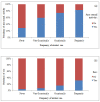Wellbeing, alcohol use and sexual activity in young teenagers: findings from a cross-sectional survey in school children in North West England
- PMID: 21067562
- PMCID: PMC2993686
- DOI: 10.1186/1747-597X-5-27
Wellbeing, alcohol use and sexual activity in young teenagers: findings from a cross-sectional survey in school children in North West England
Abstract
Background: Adolescent health is a growing concern. High rates of binge drinking and teenage pregnancies, documented in the UK, are two measures defining poor wellbeing. Improving wellbeing through schools is a priority but information on the impact of wellbeing on alcohol use, and on sexual activity among schoolchildren is limited.
Methods: A cross-sectional survey using self-completed questionnaires was conducted among 3,641 schoolchildren aged 11-14 years due to participate in a sex and relationships education pilot programme in 15 high schools in North West England. Bivariate and multivariate analyses were conducted to examine the relationship between wellbeing and alcohol use, and wellbeing and sexual activity.
Results: A third of 11 year olds, rising to two-thirds of 14 year olds, had drunk alcohol. Children with positive school wellbeing had lower odds of ever drinking alcohol, drinking often, engaging in any sexual activity, and of having sex. General wellbeing had a smaller effect. The strength of the association between alcohol use and the prevalence of sexual activity in 13-14 year olds, increased incrementally with the higher frequency of alcohol use. Children drinking once a week or more had 12-fold higher odds of any sexual activity, and 10-fold higher odds of having sex. Rare and occasional drinkers had a significantly higher odds compared with non-drinkers.
Conclusions: The relationship between wellbeing and alcohol use, and wellbeing and sexual activity reinforces the importance of initiatives that enhance positive wellbeing in schoolchildren. The association between alcohol use and sexual activity highlights the need for integrated public health programmes. Policies restricting alcohol use may help reduce sexual exposure among young teenagers.
Figures

Similar articles
-
Teenage drinking, alcohol availability and pricing: a cross-sectional study of risk and protective factors for alcohol-related harms in school children.BMC Public Health. 2009 Oct 9;9:380. doi: 10.1186/1471-2458-9-380. BMC Public Health. 2009. PMID: 19818118 Free PMC article.
-
Exploring the characteristics of newly defined at-risk drinkers following the change to the UK low risk drinking guidelines: a retrospective analysis using Health Survey for England data.BMC Public Health. 2019 Jul 8;19(1):902. doi: 10.1186/s12889-019-7240-0. BMC Public Health. 2019. PMID: 31286928 Free PMC article.
-
Associations between e-cigarette access and smoking and drinking behaviours in teenagers.BMC Public Health. 2015 Mar 31;15:244. doi: 10.1186/s12889-015-1618-4. BMC Public Health. 2015. PMID: 25886064 Free PMC article.
-
Predictors of risky alcohol consumption in schoolchildren and their implications for preventing alcohol-related harm.Subst Abuse Treat Prev Policy. 2007 May 10;2:15. doi: 10.1186/1747-597X-2-15. Subst Abuse Treat Prev Policy. 2007. PMID: 17493261 Free PMC article.
-
A Rapid Review of Sexual Wellbeing Definitions and Measures: Should We Now Include Sexual Wellbeing Freedom?J Sex Res. 2019 Sep;56(7):843-853. doi: 10.1080/00224499.2019.1635565. Epub 2019 Jul 23. J Sex Res. 2019. PMID: 31335208 Review.
Cited by
-
Impact of health behaviours and deprivation on well-being in a national sample of English young people.BMJ Paediatr Open. 2018 Nov 9;2(1):e000335. doi: 10.1136/bmjpo-2018-000335. eCollection 2018. BMJ Paediatr Open. 2018. PMID: 30498793 Free PMC article.
-
Subjective wellbeing at different spatial scales for individuals satisfied and dissatisfied with life.PeerJ. 2019 Feb 21;7:e6502. doi: 10.7717/peerj.6502. eCollection 2019. PeerJ. 2019. PMID: 30809461 Free PMC article.
-
Alcohol use among Croatian adolescents: the alignment of 13-year-old and 15-year-old girls with boys, and the impact of the COVID-19 pandemic.Croat Med J. 2024 Dec 30;65(6):483-492. doi: 10.3325/cmj.2024.65.483. Croat Med J. 2024. PMID: 39812097 Free PMC article.
-
Parental knowledge of alcohol consumption: a cross sectional survey of 11-17 year old schoolchildren and their parents.BMC Public Health. 2013 Apr 30;13:412. doi: 10.1186/1471-2458-13-412. BMC Public Health. 2013. PMID: 23631701 Free PMC article.
-
Prevalence of Chlamydia trachomatis Infection and Its Association with Sexual Behaviour and Alcohol Use in the Population Living in Separated and Segregated Roma Settlements in Eastern Slovakia.Int J Environ Res Public Health. 2017 Dec 14;14(12):1579. doi: 10.3390/ijerph14121579. Int J Environ Res Public Health. 2017. PMID: 29240704 Free PMC article.
References
-
- UNICEF. Child Poverty in Perspective: An Overview of Child Wellbeing in Rich Countries. United Nations Children Fund Innocenti Report Card No7, Innocenti Research Centre. Florence, Italy. 2007.
-
- Organisation for Economic Co-operation and Development. Chapter 2: Comparative child well-being across the OECD doing better for children. 2009.
-
- British Medical Association. Alcohol misuse: tackling the UK epidemic. BMA Board of Science. London. 2008.
Publication types
MeSH terms
LinkOut - more resources
Full Text Sources
Medical

